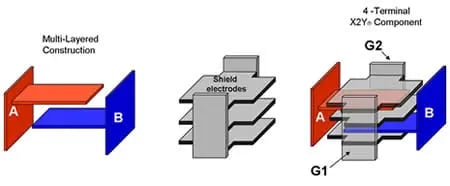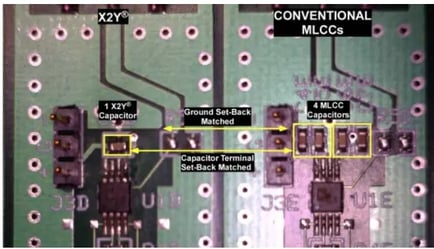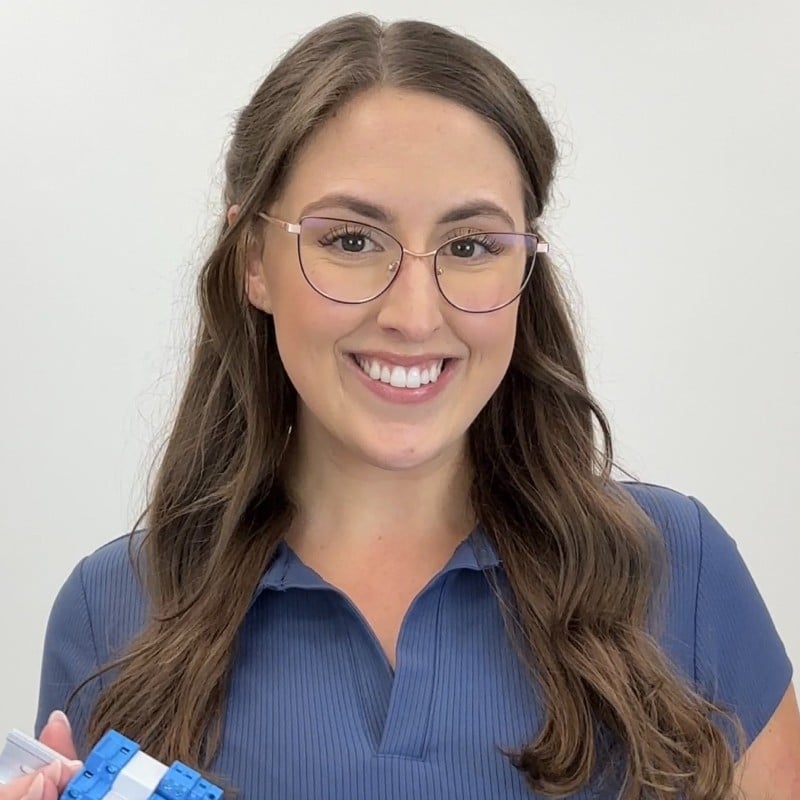X2Y® technology, which was originally developed by X2Y Attenuators, LLC, is based on a proprietary electrode arrangement embedded in passive components that can be manufactured using a variety of dielectrics. Using this innovative technology, Knowles Precision Devices manufactures high-performance multi-layer ceramic capacitors (MLCCs) that we then use to create a variety of off-the-shelf and custom bypass and noise decoupling capacitors and electromagnetic interference (EMI) filters. Let’s look at how building these components with X2Y is different than using a traditional ceramic MLCC and the resulting benefits.
.webp?width=1200&height=600&name=Knowles%20Social%20Graphics%20(3).webp)
Using X2Y for Bypass, Decoupling, and EMI Filtering Components
While a traditional bypass capacitor is designed to have stacked opposing electrode layers inside, a bypass capacitor constructed with X2Y incorporates a third set of shield electrode layers. This design effectively surrounds each existing electrode within the stack of the two-terminal capacitor, creating a three-node capacitive circuit as shown in Figure 1. With this design, there are two additional external side terminations, resulting in a four-terminal device.

Figure 1. A comparison of the construction of a traditional multi-layer bypass capacitor (left) versus one built using X2Y. Source.
When using X2Y for bypass or decoupling capacitors, you can achieve ultra-low inductance that provides broadband high-frequency bypassing, which increases circuit performance. Additionally, since this construction requires fewer passive components, system costs are also reduced.
Looking specifically at EMI filters, it’s important to note that filters using an X2Y design are manufactured in the same way as a conventional MLCC but have a special internal architecture that results in ultra-low equivalent series inductance (ESL) through opposing current flows in adjacent parallel plates. These EMI filters are not feedthrough devices, but act as bypass filters, which means they are not current limited since the only signal passing through the chip is the filtered noise to ground. These filters are ideal for twin-line applications such as motors and amplifier inputs, or twisted pair (balanced line) applications where they are fitted between the lines with the center terminal taken to ground.
Additionally, using X2Y for EMI filtering does not add DC resistance, and since two capacitors can be used in a single package, issues with aging, voltage, and temperature variations are eliminated. This means EMI filters constructed with X2Y can offer a dramatic reduction in conducted and radiated noise to meet electro-magnetic compatibility requirements.
Comparing Conventional MLCC Configurations to an X2Y Design
To illustrate some of the benefits described above, let’s look at an amplifier decoupling test performed by X2Y Attenuators, LLC. In the test configurations shown in Figure 2, the company was comparing the noise rejection power of the bypass network of four MLCCs versus the capabilities of just one bypass capacitor designed using X2Y.
.webp?width=450&height=242&name=Figure%202%20(1).webp)
Figure 2. The configuration on the left uses a single X2Y bypass capacitor while the configuration on the right is a conventional four MLCC setup.
As shown in the image of the PCBs used in the experiment in Figure 3, parasitics were equalized and the ground attachment and capacitor setbacks were matched between set-ups.

Figure 3. The actual PCB setups used in this amplifier decoupling test.
This test showed that building a conventional filter using two capacitor values per power pin, four capacitors total, resulted in 150 percent the voltage noise versus using just one X2Y capacitor for both power pins. And since a single X2Y ceramic capacitor can be used instead of four conventional MLCCs, circuit designers can drastically reduce their bill of materials (BOM) as well as the size, weight, and cost of the devices they are designing.
Overall, X2Y is an exciting, forward-thinking ceramic capacitor technology. Knowles Precision Devices is not only one of the few manufacturers developing components using this technology, but we also have expert engineers on our team to support designs using X2Y that will help you further reduce the size, weight, and cost of your designs. We also have a variety of manufacturing and testing capabilities and certifications and adjacent product lines such as AEC-Q200 qualified capacitors for automotive applications, which means no matter what industry you are working in, we are well qualified to help meet your capacitor and filter design needs.
Checkout this prior blog post to better understand EMI filtering and why it is so important to have special components for it, or browse our X2Y products offerings.

